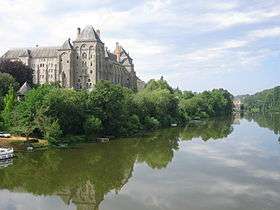Solesmes Abbey

Solesmes Abbey or St. Peter's Abbey, Solesmes (Abbaye Saint-Pierre de Solesmes) is a Benedictine monastery in Solesmes (Sarthe, France), famous as the source of the restoration of Benedictine monastic life in the country under Dom Prosper Guéranger after the French Revolution. The current abbot is the Right Reverend Dom Philippe Dupont, O.S.B.
Priory
.jpg)
Solesmes Abbey was originally founded in 1010 by Geoffrey, Lord of Sable, who donated the monastery and its farm to the Benedictine monks of the Abbey of La Couture. Unfortunately, the Abbey was sacked and burned during the Hundred Years' War but was later restored.[1]
Towards the end of the fifteenth century the rebuilding of the church was commenced, Prior Philibert de la Croix changed it from basilica form to that of a Latin cross. His successor, Jean Bougler (1505-1556), completed the restoration of the church, added the tower, and rebuilt the cloisters, sacristy, and library.[2] Under his direction two famous groups of statuary, known as the "Saints of Solesmes", were set up in the church. In the sixteenth century these masterpieces were in danger of being destroyed by the Huguenots and other Iconoclasts, but the monks saved them by erecting barricades.[3]
From the 17th century on, Solesmes Abbey underwent a slow decline under a series of commendatory priors. The superior was a layman who received part of the monastery's income without living there. However, in 1664, the monastery was aggregated to the St. Maur Congregation and a stricter monastic observance was resumed.[4]
Following the French Revolution, the newly formed National Constituent Assembly prohibited all religious vows on 13 February 1790. At Solesmes one of the seven monks (the sub-prior) broke his vows to become a constitutional priest and soldier of the Republic. At the beginning of 1791, the monks began to leave the monastery, and those who wished to remain there were imprisoned or deported to the Island of Jersey.[1] One of them, Dom Pierre Papion, then managed to hide in order to celebrate masses secretly across the region. After signing the Concordat, he became chaplain of the hospice de Sablé. Solesmes, whose occupants had been forced out in March 1791, was then commandeered as the country residence of a certain Henri Lenoir Chantelou and its archives were burned in a "civic" bonfire on 14 July 1794. The church was reopened at the time of the Concordat and the Lenoir de Chantelou family were given statues by Napoleon himself so that those at Mans were not removed.
In 1825, government property administrators sold the monastic buildings and 145 acres of with its farms. In 1832, it was decided to demolish the buildings, starting with the east wing, which has now disappeared.
Abbey
In 1831 the remaining buildings, which had escaped demolition in the Revolution but were threatened with destruction for want of a buyer, came to the attention of the locally born priest Prosper Guéranger, who, inspired by the vision of a restored monastic life in France, acquired them for the home of a new Benedictine community, which moved in on 11 July 1833.[4] Against all expectation the new community flourished and in 1837 not only received Papal approval, but was elevated to the rank of an abbey and made the head of the newly created French Benedictine Congregation, now the Solesmes Congregation within the Benedictine Confederation.[1]
In 1866 a convent, St. Cecilia's Abbey, Solesmes, was also founded at Solesmes, by Mother Cécile Bruyère (the first abbess) with the support of Dom Guéranger, which was the first house of the nuns of the Solesmes Congregation.[2]
Since its restoration Solesmes has been dissolved by the French Government no less than four times. In 1880, 1882, and 1883 the monks were ejected by force but, receiving hospitality in the neighbourhood, succeeded each time in re-entering their abbey.[3] Between 1901 and 1922 the monks were forced into exile in England. They settled on the Isle of Wight and built the present Quarr Abbey. The community survived those trials and those of two World Wars and is still at Solesmes.
As part of its mission of monastic revival the abbey has been the mother house of some twenty five other monastic foundations,[2] including the monastery at Palendriai in Lithuania.
The abbey is noted for its crucial contribution to the advancement of the Roman Catholic liturgy and the revival of Gregorian chant. A documentary film on life at Solesmes was made in 2009 and focuses on the tradition of the chant at the monastery.[5]
See also
References
- 1 2 3 "Solesmes Abbey Celebrates 1,000 Years", Zenit, October 13, 1010
- 1 2 3 "Solesmes Abbey: The Unquiet Home of Gregorian Chant", Regina Magazine, September 25, 2014
- 1 2 Alston, George Cyprian. "Abbey of St. Solesmes." The Catholic Encyclopedia. Vol. 14. New York: Robert Appleton Company, 1912. 23 March 2015
- 1 2 "History", Abbaye Saint-Pierre Solesmes
- ↑ 'Moine au Coeur de l’Eglise', 2009. Documentary (34’), Language: French/English, Director: Regis Ghezelbash
External links
| Wikimedia Commons has media related to Solesmes Abbey. |
Coordinates: 47°51′8″N 0°18′11″W / 47.85222°N 0.30306°W